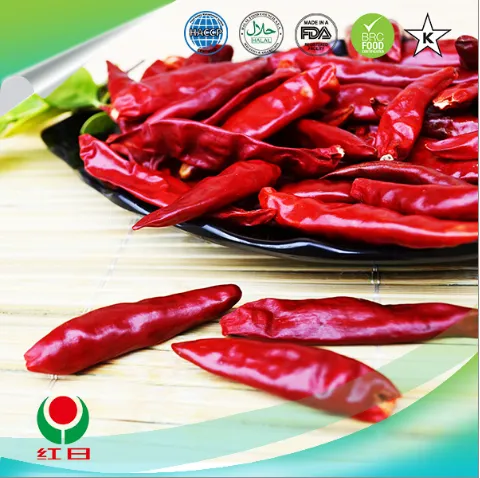- ਨੰਬਰ 268 Xianghe ਸਟ੍ਰੀਟ, Xingtai ਸ਼ਹਿਰ ਦੇ ਆਰਥਿਕ ਵਿਕਾਸ ਜ਼ੋਨ, Hebei 054001 ਚੀਨ
- Byron@hbhongri.cn
Crushed Red Chili Pepper in Global Cuisines: A Fiery Journey
Crushed red chili pepper is more than a spice; it is a symbol of flavor, heat, and cultural identity. This fiery condiment has traveled across continents, becoming a vital ingredient in a variety of cuisines worldwide. Whether adding heat to a dish or enhancing its complexity, crushed red chili pepper plays a starring role in culinary traditions from Asia to the Americas.

Origins and Global Spread About Crushed Red Chili Pepper
The journey of ਕੱਟੀ ਹੋਈ ਲਾਲ ਮਿਰਚ began in the Americas, where chili peppers were first domesticated thousands of years ago. Indigenous cultures used chili peppers not only for their heat but also for their medicinal properties and symbolic significance. The introduction of chili peppers to Europe, Asia, and Africa followed the Columbian Exchange, where they were embraced and adapted into local cuisines. Over time, crushed red chili pepper became a popular way to harness the pepper’s flavor and intensity.
A Staple in Asian Cuisine About Crushed Red Chili Pepper
In Asian cooking, crushed hot peppers is an essential ingredient, adding a fiery dimension to countless dishes. In Chinese cuisine, it enhances stir-fries, noodle soups, and Sichuan-style dishes, where its heat complements the numbing sensation of Sichuan peppercorns. Indian cuisine relies on crushed red chili pepper for curries, chutneys, and pickles, providing depth and warmth to its vibrant flavors. In Korea, it is a crucial component of gochugaru, a key ingredient in kimchi and other fermented delicacies.
Enhancing Mediterranean and Middle Eastern Flavors With Crushed Red Chili Pepper
Mediterranean and Middle Eastern cuisines incorporate crushed red chili pepper to balance earthy, tangy, and savory notes. In Italian cooking, it is a favorite topping for pizzas, pastas, and seafood dishes, lending a subtle yet tantalizing heat. Middle Eastern cuisine uses it in spice blends like harissa and za’atar, as well as in meat marinades and roasted vegetable dishes. These cuisines highlight the versatility of crushed red chili pepper, using it to enhance both simple and complex flavors.
Heat in the Americas About Crushed Red Chili Pepper
In the Americas, crushed red chili pepper reflects the region’s deep connection to chili peppers. Mexican cuisine celebrates its heat in salsas, tacos, and traditional moles, where it pairs with chocolate, nuts, and spices to create rich and nuanced flavors. In the United States, it is a common table seasoning, especially in pizzerias, where it adds a kick to slices of pizza. Latin American dishes like chimichurri, empanadas, and grilled meats also benefit from its fiery zest.
African Spice Traditions About Crushed Red Chili Pepper
Crushed red chili pepper holds a special place in African cooking, where it brings boldness to stews, grilled meats, and spice blends. In North Africa, it is a key ingredient in the fiery paste harissa, used to season couscous, tagines, and soups. Sub-Saharan African cuisines incorporate it in sauces and relishes, where its heat complements ingredients like tomatoes, onions, and garlic. This spice embodies the dynamic flavors of the continent, showcasing its adaptability across various dishes.
Fusion and Modern Applications About Crushed Red Chili Pepper
The global appeal of crushed red chili pepper has inspired fusion cuisine, where traditional dishes are reinvented with a spicy twist. Chefs and home cooks alike experiment with its heat in unexpected ways, from spicy desserts like chili-infused chocolate to cocktails with a hint of crushed red chili in the rim salt. Its versatility also extends to vegan and vegetarian cooking, where it adds excitement to plant-based dishes like roasted vegetables, tofu scrambles, and grain bowls.
Tips for Culinary Use About Crushed Red Chili Pepper
Crushed red chili pepper is an easy and versatile way to add heat to dishes. Its heat level can vary depending on the type of chili used, so tasting and adjusting to your preference is key. It can be sprinkled on finished dishes for a burst of flavor or added during cooking for a more integrated heat. Pairing it with complementary ingredients like garlic, lemon, or olive oil enhances its flavor, while balancing its heat with creamy or sweet elements can create a harmonious dish.
-
Capsicum frutescens oleoresin – High Purity, Food Gradeਖ਼ਬਰਾਂNov.17,2025
-
Capsicum Frutescens Oleoresin – Natural Heat & Flavorਖ਼ਬਰਾਂNov.17,2025
-
Peppereka Powder – Fresh, Vibrant Color & Sweet Aromaਖ਼ਬਰਾਂNov.17,2025
-
Paprika Oleoresin | Natural Red Color, Heat & Flavor Boostਖ਼ਬਰਾਂNov.17,2025
-
Pure Turmeric Extract 95% Curcumin | Potent, Lab-Testedਖ਼ਬਰਾਂNov.17,2025
-
Red Papper Pods – Premium Sun-Dried, Bold Heat & Aromaਖ਼ਬਰਾਂNov.10,2025







